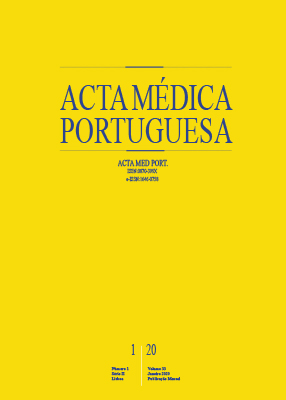Appropriateness of Radiology Test Requests by an Emergency Department: A Retrospective Study
DOI:
https://doi.org/10.20344/amp.12075Keywords:
Diagnostic Imaging/statistics & numerical data, Emergency Service, Hospital, Practice Patterns, Physicians, Radiology Department, Unnecessary ProceduresAbstract
Introduction: Imaging tests are essential for diagnosis in the emergency context and convey clinical information that is essential to assess the appropriateness of the tests and improve their interpretation. Therefore, we aimed to analyze the imaging tests requested by the Emergency Department in a district hospital.
Material and Methods: We retrospectively analyzed computed tomography and ultrasound scans requested by the Emergency Department at the Centro Hospitalar Universitário do Algarve and considered the following variables: requested test, clinical information provided (complete/incomplete), appropriateness of the test (appropriate/inappropriate), outcome (presence/absence of relevant findings) and findings related to the clinical information (yes/no). Pearson’s chi-squared and odds ratio association tests were used to evaluate the statistical association between the variables.
Results: Out of 1427 requests, only 219 (15.3%) were considered to have complete clinical information. Nonetheless, 1075 (75.3%) requests were considered appropriate. Relevant findings were present in about one-third (n = 453; 31.7%) and most of these findings were related to the clinical context (n = 410; 90.5%). There was a significant association between test appropriateness and the presence of relevant findings in the test (p < 0.001). The odds ratio of having a relevant finding was 5.0 times higher in the tests considered appropriate when compared with those classified as inappropriate (CI = 3.4 - 7.3; p < 0.001).
Discussion: The fact that appropriate tests potentiate the probability of having a relevant finding emphasizes the importance of defining guidelines so that only the adequate tests are performed.
Conclusion: Creating guidelines should improve the appropriateness of imaging tests requested in the Emergency Department, yielding their result, with the consequent rationalization of the available resources.
Downloads
Downloads
Published
How to Cite
Issue
Section
License
All the articles published in the AMP are open access and comply with the requirements of funding agencies or academic institutions. The AMP is governed by the terms of the Creative Commons ‘Attribution – Non-Commercial Use - (CC-BY-NC)’ license, regarding the use by third parties.
It is the author’s responsibility to obtain approval for the reproduction of figures, tables, etc. from other publications.
Upon acceptance of an article for publication, the authors will be asked to complete the ICMJE “Copyright Liability and Copyright Sharing Statement “(http://www.actamedicaportuguesa.com/info/AMP-NormasPublicacao.pdf) and the “Declaration of Potential Conflicts of Interest” (http:// www.icmje.org/conflicts-of-interest). An e-mail will be sent to the corresponding author to acknowledge receipt of the manuscript.
After publication, the authors are authorised to make their articles available in repositories of their institutions of origin, as long as they always mention where they were published and according to the Creative Commons license.









